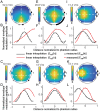Transcranial temporal interference stimulation precisely targets deep brain regions to regulate eye movements
- PMID: 40214945
- PMCID: PMC12314165
- DOI: 10.1007/s12264-025-01387-3
Transcranial temporal interference stimulation precisely targets deep brain regions to regulate eye movements
Abstract
Transcranial temporal interference stimulation (tTIS) is a novel non-invasive neuromodulation technique with the potential to precisely target deep brain structures. This study explores the neural and behavioral effects of tTIS on the superior colliculus (SC), a region involved in eye movement control, in mice. Computational modeling revealed that tTIS delivers more focused stimulation to the SC than traditional transcranial alternating current stimulation. In vivo experiments, including Ca2+ signal recordings and eye movement tracking, showed that tTIS effectively modulates SC neural activity and induces eye movements. A significant correlation was found between stimulation frequency and saccade frequency, suggesting direct tTIS-induced modulation of SC activity. These results demonstrate the precision of tTIS in targeting deep brain regions and regulating eye movements, highlighting its potential for neuroscientific research and therapeutic applications.
Keywords: Eye movement; Finite element method; Superior colliculus; Temporal interference stimulation; Tissue phantom; Transcranial electrical stimulation.
© 2025. The Author(s).
Conflict of interest statement
Conflict of interest: The authors declare that they have no known competing financial interests or personal relationships that could have appeared to influence the work reported in this paper.
Figures






References
-
- Yu WS, Aquili L, Wong KH, Lo ACY, Chan LLH, Chan YS. Transcorneal electrical stimulation enhances cognitive functions in aged and 5XFAD mouse models. Ann N Y Acad Sci 2022, 1515: 249–265. - PubMed
-
- Van Schuerbeek A, Vanderhasselt MA, Baeken C, Pierre A, Smolders I, Van Waes V, et al. Effects of repeated anodal transcranial direct current stimulation on auditory fear extinction in C57BL/6J mice. Brain Stimul 2021, 14: 250–260. - PubMed
-
- Vanderhasselt MA, De Raedt R, Namur V, Lotufo PA, Bensenor IM, Boggio PS, et al. Transcranial electric stimulation and neurocognitive training in clinically depressed patients: A pilot study of the effects on rumination. Prog Neuropsychopharmacol Biol Psychiatry 2015, 57: 93–99. - PubMed
MeSH terms
LinkOut - more resources
Full Text Sources
Miscellaneous

